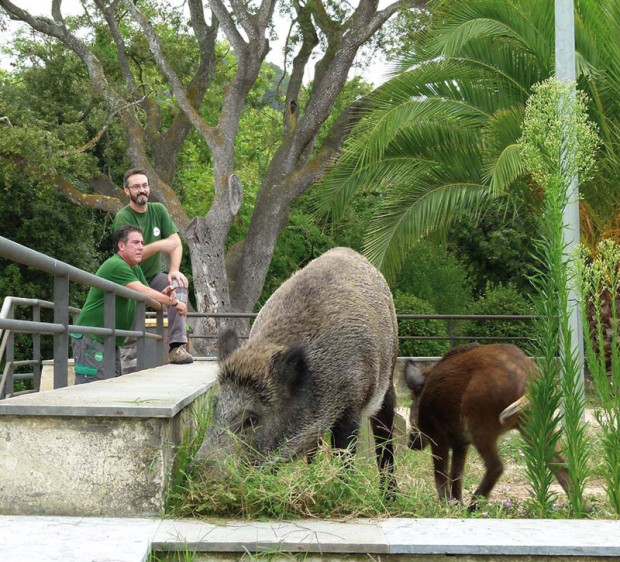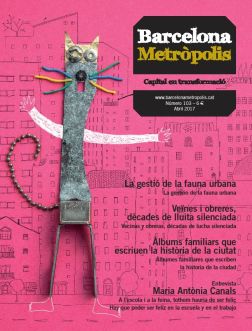Once they have got used to human food, wild boar cannot re-adapt to their natural feeding habits and the only viable solution is to cull them, for ethical, legal, public liability, administrative and health reasons.

Workers at the Serra de Collserola Natural Park observing two boars on the grounds of the old Vil•la Joana farmhouse, near its consortium headquarters.
Photo: A. Raspall / Parc Natural de la Serra de Collserola
The wild boar (Sus scrofa) is a native species in Catalonia. In recent years, it has proliferated to the point that we have seen an increase in incidents caused by their presence in several populated areas around Collserola, including Barcelona.
Wild boars are not an urban species and should therefore not be in the urban environment. Work must be done to keep it native to the natural environment and to remove it from the city. Since 2013, the Department of Wildlife Ecopathology (SEFaS) at the Autonomous University of Barcelona (UAB) has been contracted by the City Council to study the urbanisation of wild boar and how to remedy the situation.
You might think that the presence of wild boar in urban areas is because of an increase in their population, but if the boar did not find sources of food, they would not be frequenting the city. Urban food sources (troughs, food for cats, waste, etc.) are the reason that boar are colonising the urban environment in a process of adaption that has been evolving over several generations.
Once they have got used to human food, wild boar cannot be retrained to return to their natural feeding habits and the only viable solution is to cull them, for ethical, legal, civil liability, administrative and health reasons. To feed them or to give them access to human food is to pass a death sentence on them and their descendants.
The reproductive strategy of the boar is to have many piglets each year to ensure that some of them survive. By providing them with food in the city at times of short supply in the wild, the negative impact is twofold: firstly, the population increases because the young improve their chances of survival and, secondly, the animals get used to people and to the urban environment. People living in the city must learn and be aware that individual wild animals must be culled in order to control the population.
In the short term, any wild boar that causes incidents in an urban area has to be put down, because of the risks it brings and because it cannot be re-introduced into the wild. In the medium and long term, steps must be taken to reduce the wild boar population in the Collserola hills while also reducing the availability of food in the urban areas. According to studies conducted by SEFaS and corroborated by the experiences of other European countries, reducing the population is more effective if the effort is concentrated on culling the young and subadult population.
However, to avoid incidents in urban areas, reducing the boar population is not enough. It has to go hand-in-hand with a reduction in the food they receive from direct feeding, from the food put out for cats, from rubbish and from vegetation in the city’s green spaces. This means that there has to be a system of fines for deliberately feeding the boar or for feeding pets and urban animals such as cats in an irresponsible manner. Urban cat colonies have to be better managed and green spaces should be redesigned to make them less attractive to wild boar, especially at key locations in the neighbourhoods that border Collserola.
Barcelona City Council and the SEFaS are launching a public awareness campaign to reduce the growing availability of food for wild boar in urban areas. This campaign also involves monitoring the measures taken, in order to assess their effectiveness. The idea is to reverse a process of adaptation that has taken place over many years. Despite our best efforts, there will be no immediate results, but we must still start working now, and not be discouraged.
*They also sign this article: Raquel Castillo Contreras, Carlos González Crespo, Carlos Conejero Fuentes, Gregorio Mentaberre (Department of Wildlife Ecopathology at the UAB)



